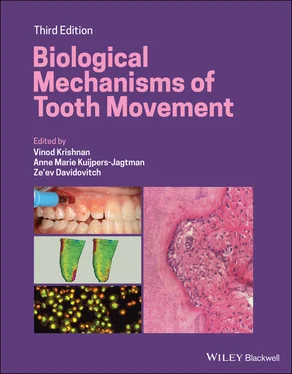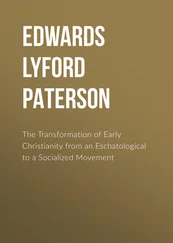The body of knowledge that has evolved from multilevel orthodontic research supports the notion that the patient’s biology is an integral part of orthodontic diagnosis, treatment planning, and treatment. Therefore, orthodontic appliances and procedures should be designed to address the patient’s malocclusion in light of his/her biological profile, in much the same fashion as is done by medical specialists in other fields of medicine. As outlined by Jheon et al . (2017), analyses of genetic and molecular factors may soon uncover indicators predicting slow tooth movement, increased predisposition to root resorption, and accelerated late stage skeletal growth. Patients will be provided with customized appliances printed through the treatment stages, as per the devised virtual plan. In addition, specific biologic/pharmacologic agents based on patients’ molecular and genetic background will be delivered to enhance treatment efficiency and outcomes.
Orthodontics started in ancient times by pushing malposed teeth with a finger for a few minutes a day, but today we know that the reason teeth can be moved is because cells respond to changes in their physical and chemical environment. Research will continue to unravel new details of this process, and the beneficiaries will be all people seeking and receiving orthodontic care.
1 Abass, S. K. and Hartsfield, J. K. Jr. (2006) Genetic studies in root resorption and orthodontia, in Biological Mechanisms of Tooth Eruption, Resorption, and Movement (eds Z. Davidovitch, J. Mah, and S. Suthanarak). Harvard Society for the Advancement of Orthodontics, Boston, pp. 39–46.
2 Asbell, M. B. (1990) A brief history of orthodontics. American Journal of Orthodontics and Dentofacial Orthopedics 98(2), 176–183.
3 Asbell M. B. (1998) John Nutting Farrar 1839–1913. American Journal of Orthodontics and Dentofacial Orthopedics 114, 602.
4 Bartzela, T., Turp, J. C., Motschall, E. and Maltha, J. C. (2010) Medication effects on the rate of orthodontic tooth movement: A systematic literature review. American Journal of Orthodontics and Orofacial Orthopedics 135, 16–26.
5 Bassett, C. A. L. and Becker, R. O. (1962) Generation of electrical potentials in bone in response to mechanical stress. Science 137, 1063–1064.
6 Baumrind, S. (1969) A reconsideration of the propriety of the “pressure‐tension” hypothesis. American Journal of Orthodontics 55, 12–22.
7 Bien, S. M. (1966) Hydrodynamic damping of tooth movement. Journal of Dental Research 45, 907–914.
8 Bister, D. and Meikle, M. C. (2013) Re‐examination of “Einige Beiträge zur Theorie der Zahnregulierung” (Some contributions to the theory of the regulation of teeth) published in 1904–1905 by Carl Sandstedt. European Journal of Orthodontics 35, 160–168.
9 Caster, F. M. (1934) A historical sketch of orthodontia. Dental Cosmos 76(1), 110–135.
10 Davidovitch, Z., Finkelson, M. D., Steigman, S. et al. (1980c) Electric currents, bone remodeling, and orthodontic tooth movement. II. Increase in rate of tooth movement and periodontal cyclic nucleotide levels by combined force and electric current. American Journal of Orthodontics 77, 33–47.
11 Davidovitch, Z., Gogen, M. H., Okamoto, Y. and Shanfeld, J. L. (1992) Neurotransmitters and cytokines as regulators of bone remodeling, in Bone Biodynamics in Orthodontic and Orthopedic Treatment (eds D. S. Carlson and S. A. Goldstein). University of Michigan Press, Ann Arbor, MI, pp. 141–162.
12 Davidovitch, Z., Korostoff, E., Finkelson, M. D. et al. (1980a) Effect of electric currents on gingival cyclic nucleotides in vivo. Journal of Periodontal Research 15, 353–362.
13 Davidovitch, Z., Montgomery, P. C., Eckerdal, O. and Gustafson, G. T. (1976) Demonstration of cyclic AMP in bone cells by immuno‐histochemical methods. Calcified Tissue Research 19, 317–329.
14 Davidovitch, Z., Montgomery, P. C., Yost, R. W. and Shanfeld, J. L. (1978) Immunohistochemical localization of cyclic nucleotides in the periodontium: Mechanically‐stressed osteoblasts in vivo. The Anatomical Record 192, 351–361.
15 Davidovitch, Z., Okamoto, Y., Gogen, H. et al. (1996) Orthodontic forces stimulate alveolar bone marrow cells. In: Biological Mechanisms of Tooth Movement and Craniofacial Adaptation (eds Z. Davidovitch and L. A. Norton). Harvard Society for the Advancement of Orthodontics, Boston, pp. 255–270.
16 Davidovitch, Z., Steigman, S., Finkelson, M. D. et al. (1980b) Immunohistochemical evidence that electric currents increase periosteal cell cyclic nucleotide levels in feline alveolar bone in vivo. Archives of Oral Biology 25, 321–327.
17 Fauchard, P. (1728) Le chirurgien dentiste ou traite des dents (trans. Lilian Lindsay). Butterworth, London.
18 Franceschi, R. T. (2005) Biological approaches to bone regeneration by gene therapy. Journal of Dental Research 84, 1093–1103.
19 Gillooly, C. J., Hosley, R. T., Mathews, J. R. and Jewett, D. L. (1968) Electrical potentials recorded from mandibular alveolar bone as a result of forces applied to the tooth. American Journal of Orthodontics 54, 649–654.
20 Gluhak‐Heinrich, J., Ye, L., Bonewald, L. F. et al. (2003) Mechanical loading stimulates dentin matrix protein 1 (DMP1) expression in osteocytes in vivo. Journal of Bone and Mineral Research 18, 807–817.
21 Grimm, F. M. (1972) Bone bending, a feature of orthodontic tooth movement. American Journal of Orthodontics 62, 384–393.
22 Jheon, A. H., Oberoi, S., Solem, R. C. and Kapila, S. (2017). Moving towards precision orthodontics: An evolving paradigm shift in the planning and delivery of customized orthodontic therapy. Orthodontics & Craniofacial Research 20, 106–113.
23 Kanzaki, H., Chiba, M., Takahashi, I. et al. (2004) Local OPG gene transfer to periodontal tissue inhibits orthodontic tooth movement. Journal of Dental Research 83, 920–925.
24 Ketcham, A. H. (1927) A preliminary report of an investigation of apical root resorption of permanent teeth. International Journal of Orthodontia, Oral Surgery and Radiography 13(2), 97–127.
25 Ketcham, A. H. (1929) A progress report of an investigation of apical root resorption of vital permanent teeth. International Journal of Orthodontia, Oral Surgery and Radiography 15(4), 310–328.
26 Kingsley, N. W. (1880) A Treatise on Oral Deformities, Birmingham, Alabama.
27 Kornman, K. S. and Duff, G. W. (2012) Personalized medicine: will dentistry ride the wave or watch from the beach? Journal of Dental Research 91(suppl.), 8S–11S.
28 Kvam E. (1972) Scanning electron microscopy of tissue changes on the pressure surface of human premolars following tooth movement. Scandinavian Journal of Dental Research 80, 357–368.
29 Lilja, E., Lindskog, S. and Hammarström, I. (1983) Histochemistry of enzymes associated with tissue degradation incident to orthodontic tooth movement. American Journal of Orthodontics 83, 62–75.
30 Mayahara, K., Yamaguchi, A., Takenouchi, H. et al. (2012) Osteoblasts stimulate osteoclastogenesis via RANKL expression more strongly than periodontal ligament cells do in response to PGE(2). Archives of Oral Biology 57(10), 1377–1384.
31 Meikle, M. C., Heath, J. K., Atkinson, S. J. et al. (1989) Molecular biology of stressed connective tissues at sutures and hard tissues in vitro, in The Biology of Tooth Movement (eds L. A. Norton and C. J. Burstone). CRC Press, Boca Raton, FL, pp. 71–86.
32 Noyes, F. B. (1945) The contribution of Albin Oppenheim to orthodontia. The Angle Orthodontist 15, 47–51.
33 Oppenheim, A. (1911/1912) Tissue changes, particularly of the bone, incident to tooth movement. American Journal of Orthodontics 3, 113–132.
34 Otero, L., García, D. A. and Wilches‐Buitrago, L. (2016). Expression and presence of OPG and RANKL mRNA and protein in human periodontal ligament with orthodontic force. Gene Regulation and Systems Biology 10, 15–20.
Читать дальше












